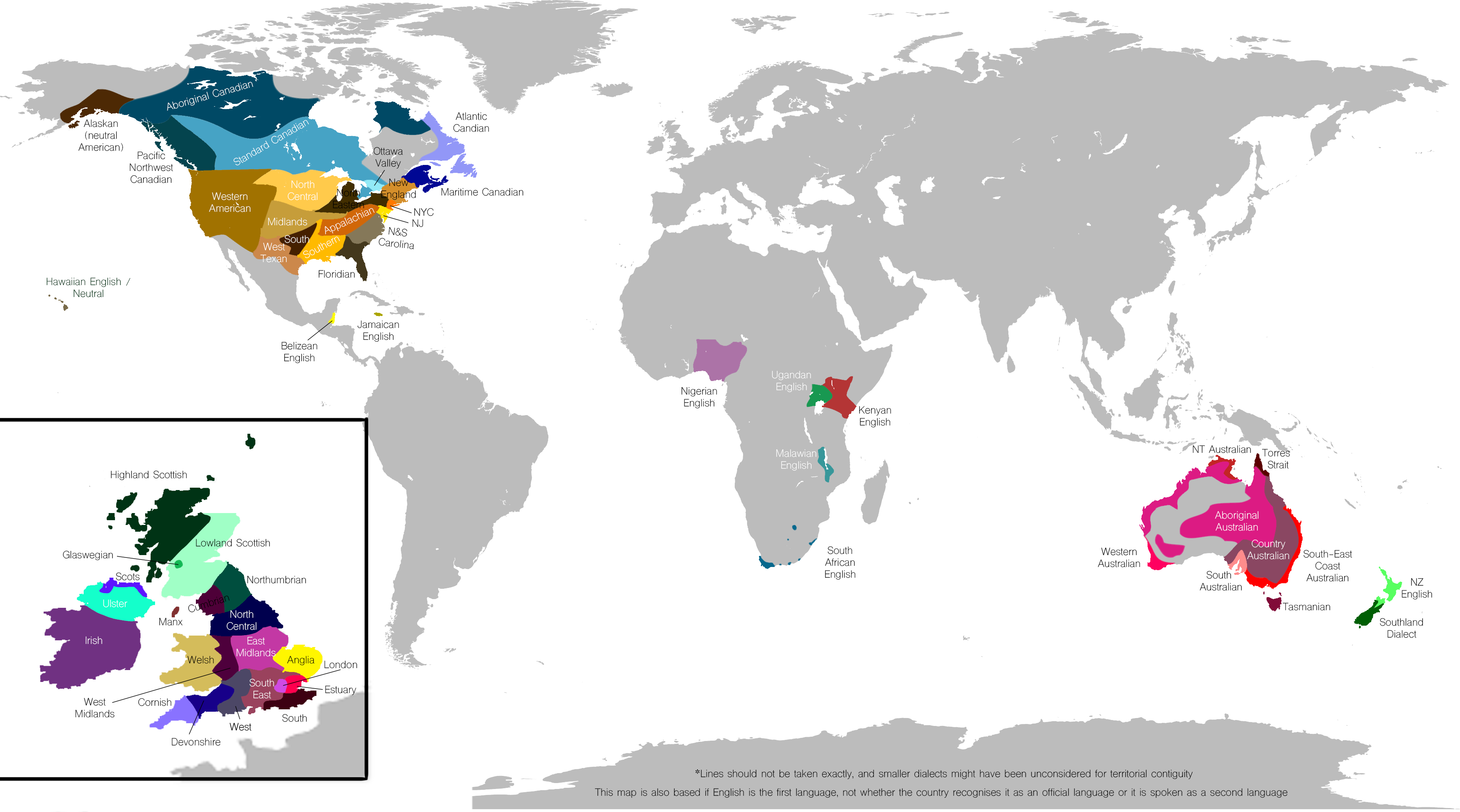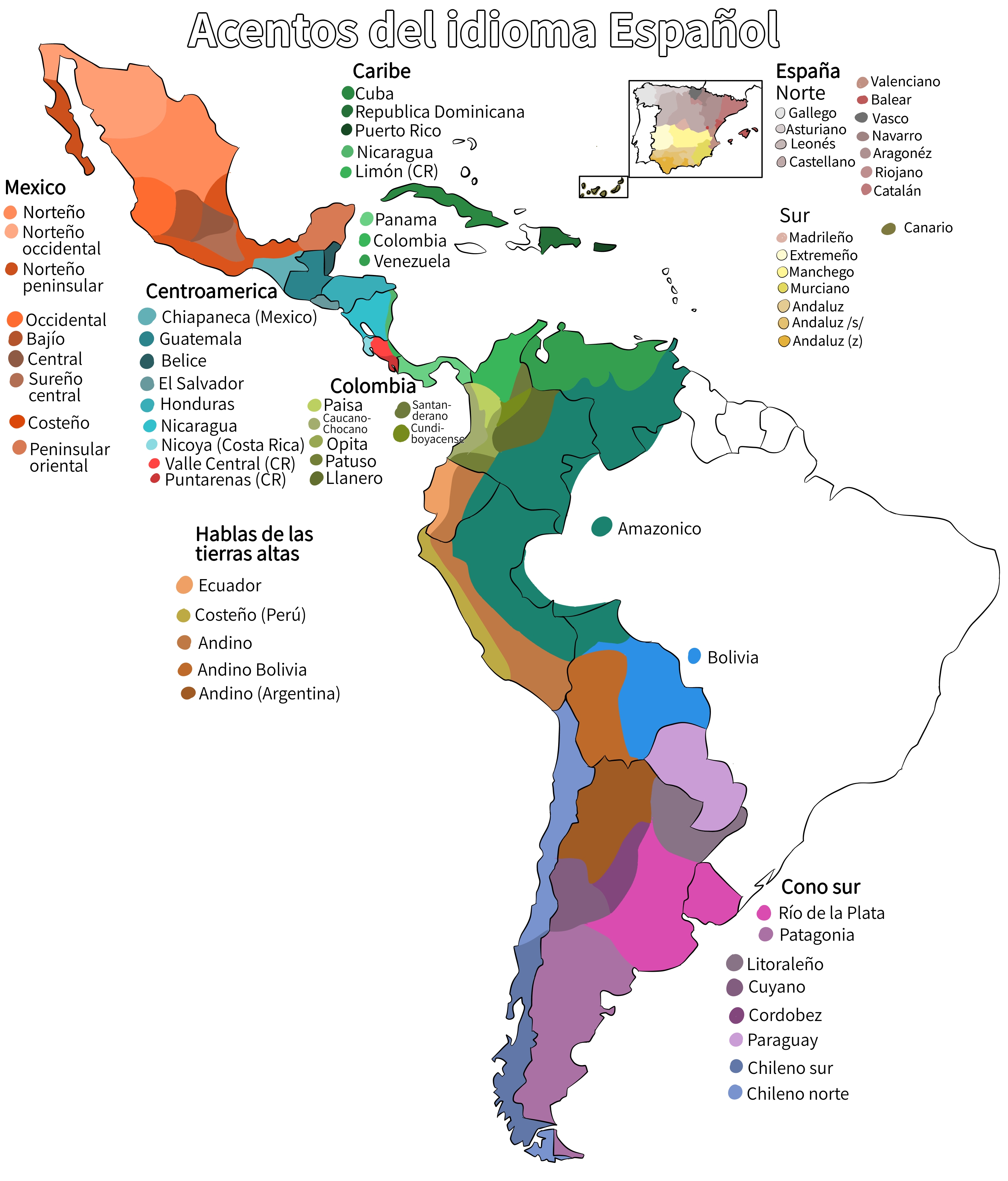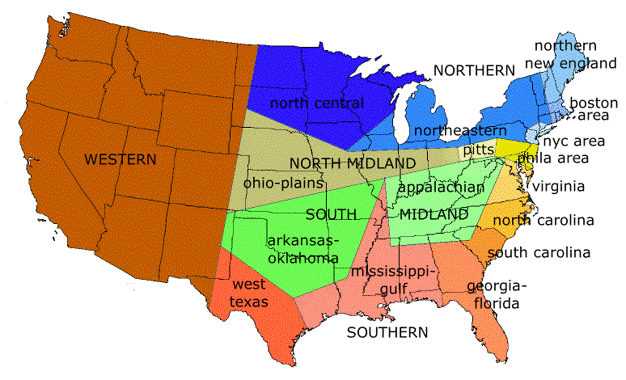2: Geographic dialects
- Page ID
- 114723
Various Accents of English, in Anderson's Essentials of Linguistics
Overview of English Accents
The British Isles
The Western Hemisphere
The Southern Hemisphere
Non-native accents
Geographic Dialects, from Sarah Harmon
Video Script
Catherine's explanation of a geographic dialect, I think, needs a little more fleshing out. Certainly, this is the case when we talk about English as a global language. I'm going to expand a little bit more than what she has in her section on geographic dialects, and instead focus a little bit more on our next few topics.
When we talk about geographic dialects, we’re talking about the dialects that arise because of geographic isolation. Take a look at this map of global English.

Notice that you have two full continents where English was brought and dominated the entirety of the continent. When we talk about North America, and when we talk about Australia (including New Zealand), English has dominated those continents. We have to add Africa because, in certain parts, like over in eastern Africa where Kenya is, for the most part we have English is an official language. In the area around Nigeria, of course, English is an official language, and then, of course, South Africa, especially the cities on the coast, English is pretty much a mainstay.
Those are just the colonies, to say nothing of the United Kingdom and Ireland, where, of course, we have had English for close to 2,000 years. Notice that just this one little island—and realistically, you can talk about southeast England where London is—for the most part, it is from there, and the policies that come out of that city, that you get English spreading, not just through the British Isles, but throughout the world, as part of the original British Empire.
Now, lest you think that that is the only thing to say about that, just think about North America alone, the United States and Canada. Think about how many different dialects that we have, not to mention Mainstream American English (MAE) and Mainstream Canadian English (MCE). Just looking at that section of North America is pretty stunning. It tells us that we have a lot of different geographic dialects within North America. We're going to take a look at some of that in a little bit more detail.
As you have no doubt guessed, this is not just an English-centric course; it's important to think about, for example, a language like Spanish, with the same kind of colonization of history. As a result of very wide spread of different geographic dialects from that one country of Spain, we can count two main areas, the provinces of Extremadura and Andalucía, as where the majority of Spaniards left to colonize the western hemisphere. Everything from Mexico down to the very tip of South America, all of these areas colonized mostly by people from the southern half and the eastern half of Spain. We have the Spanish-speaking islands of the Caribbean as well. Notice the different dialects that we have.
When we talk about a global language, English is not the only one to keep in mind. Spanish is definitely in there and, certainly, you can count Mandarin. It is part of that equation when you factor in the number of places throughout Asia and beyond where Mandarin is a major player linguistically. When we think about the isolation that happens as a result of colonization, frequently it's not just because you have left the homeland, the old country. Rather, it’s because you're moving to a place that may be cut off geographically or, certainly for several generations, you might be cut off from the others in the region. Eventually there's more spreading of the dialect.
It is also important to understand that when we talk about a global language, there are still considered mainstream tendencies, and Spanish is a really good example of this.

There are differences within each one of these dialects, each one of these colors that you see. Latin American Spanish has certain characteristics that Spain (Castilian) Spanish, including the Canary Islands, do not share. The reverse is true, too. We aren't just talking about different sounds; we're talking about parts of the verb conjugation, and the structuring of syllables is entirely different depending on what dialect you speak.
One important note, if you didn't know this about the history of Spanish is that for about the last 150 years, the prestige Latin American dialect is not Mexican; it's Colombian. By Latin Americans themselves, they frequently state that Colombian Spanish—particularly up in the Andean region near Bogotá, Medellín, and that area—has the clearest Spanish that anyone has spoken. Linguistically, we don't hold that prestige; we can mark it, we can observe it, but we don't hold it. I find it interesting that even most Spanish speakers in the United States don't realize that Mexican Spanish is not carry quite the amount of prestige just certain others. However, I will say in the last 25 to 30 years it has changed, due to the power of the Mexican government and the Mexican economy, that they have held a little bit more prestige in the last 25ish years. Where we'll go, who knows.
Let's focus on the United States because I find this to be also an interesting tale. This is a geographic map of the dialects of North American English with specific reference to the lower 48 states of the United States of America.

I phrase it that way because of a few things. If you think about Alaska, which is way well probably off screen, and if you think about Hawaii, which is way probably off screen as well, those are two very isolated places, so we don't count them when we talk about Mainstream American English. We're not usually going to count Alaskan or Hawaiian English; we're going to talk about the lower 48. If you remember your American history, and if you think about the original 13 colonies, you see that is where the most fractured area with respect to linguistic data we have. It makes some sense; the established colonies had some isolation and then, as we expanded west, we grew more general and more general.
Appalachian English is something that we will focus on in this class to bring just some understanding of it. It is a full, completely rich and historic dialect of American English; in fact, it really connects us to our English ancestors.
I will also tell you that here in the Bay Area, we have our own dialect. It's actually a subdialect. As somebody who's not only born and raised in San Mateo California—notice I said [sæm:ətejə]. I didn't say [sæn məteʲoʷ] I said [sæm:ətejə]. I live, not in [sæn hoʷzeʲ] I live in [sænəoʷzeʲ]. My dad, he was not born in Sacramento [sækɹəmɛntoʷ] he was born in [sækəmɛnə]. This is San Francisco Bay Area English; there's just so much that I can say about this. I'll leave it for another time; perhaps I should have said there's hella things that I can say about this dialect. It obviously has a bit of a piece of my heart. It is true that those of us were born and raised here, and especially if our parents were also born and raised here—in my case, it was my mother—we're going to have a distinct dialect of our own.
Every place where there is some kind of isolation, there will be a dialect that springs up. Whether it stays or whether it disappears, that's always the question. For now, let's leave it at this: we're going to start looking at different dialects about what they do. We look at these dialects, but we do not pass judgment; we do not say they are inferior. In fact, they are on a level playing field; everybody deserves the same amount of respect so first up is Appalachian English.

